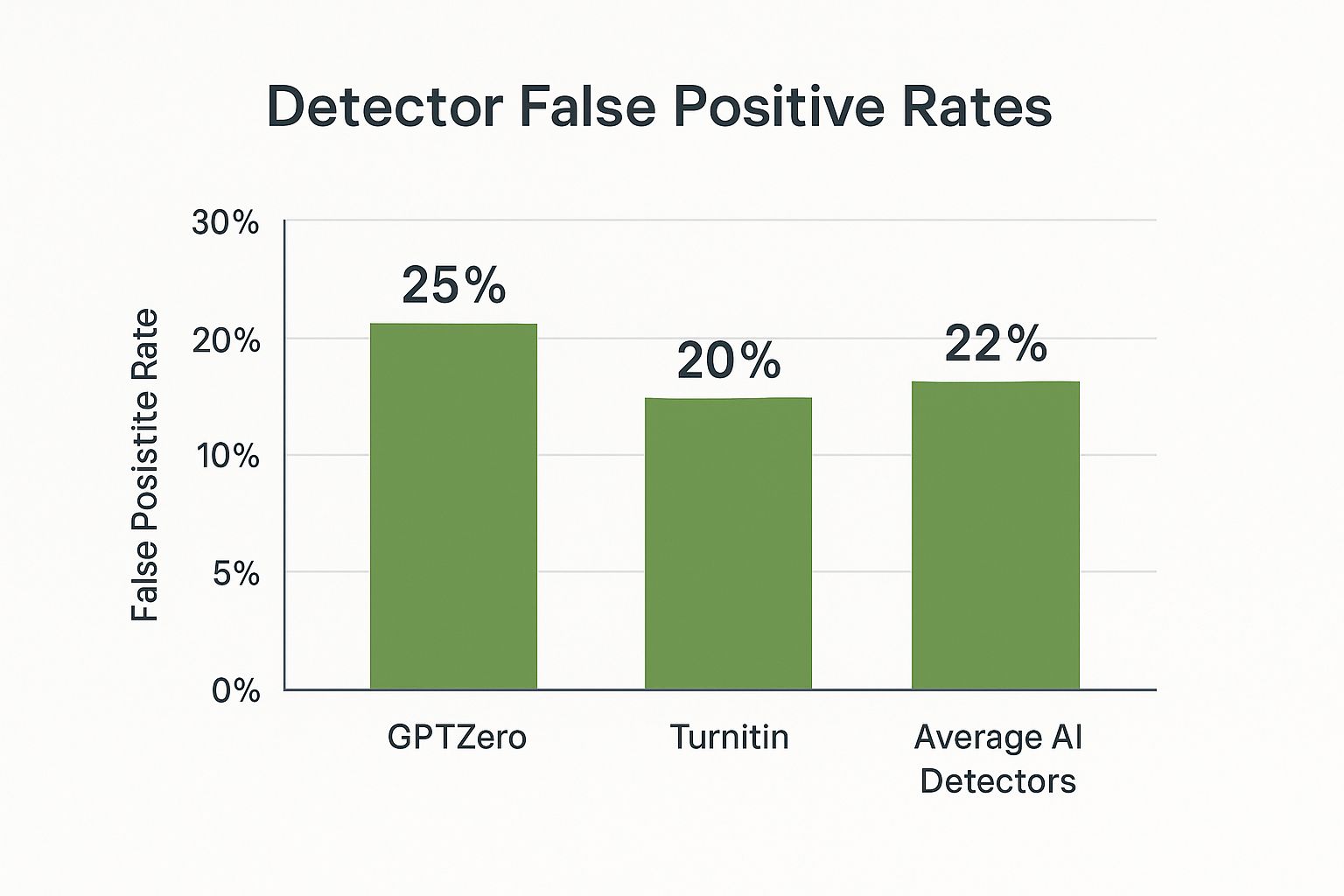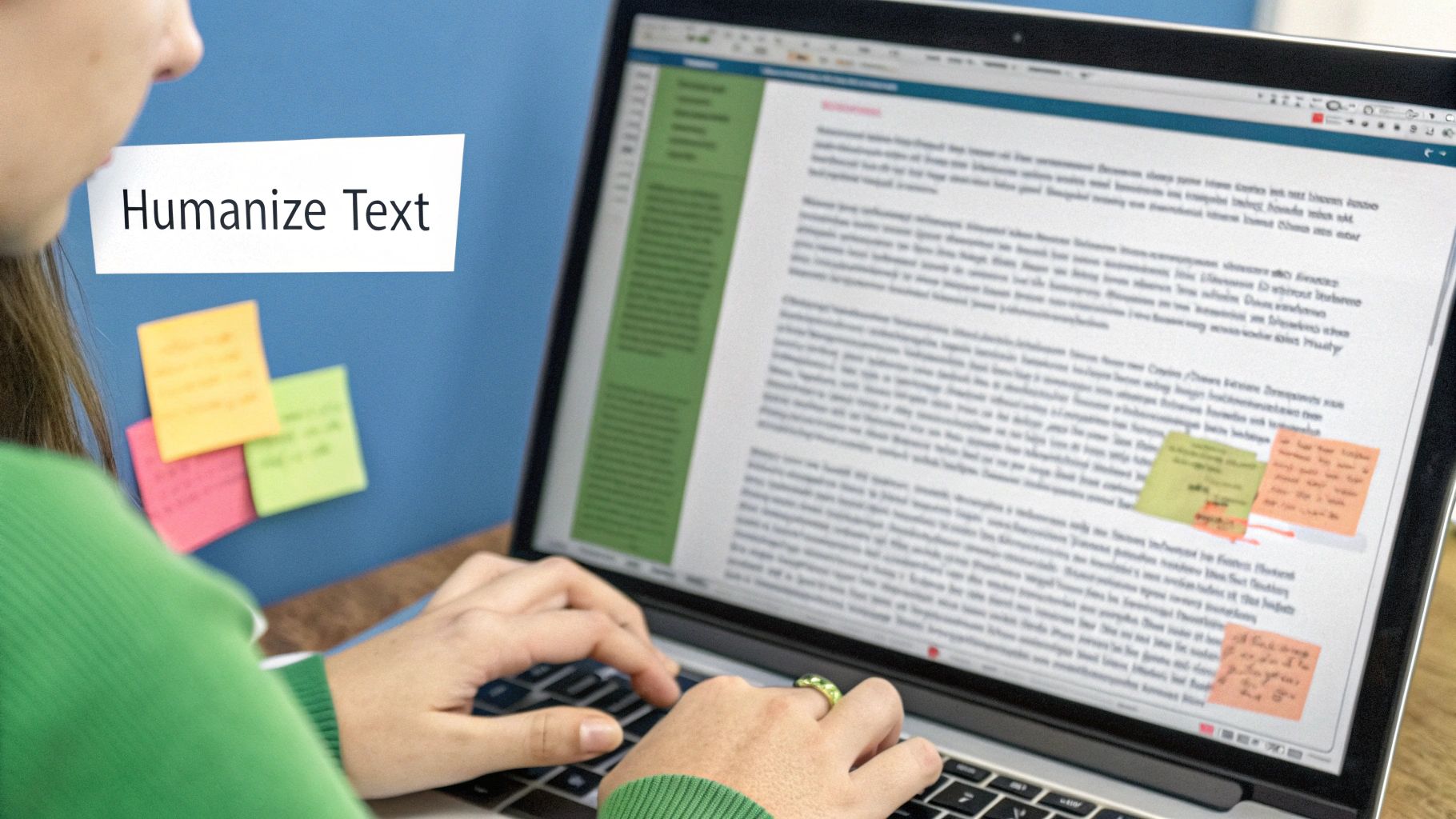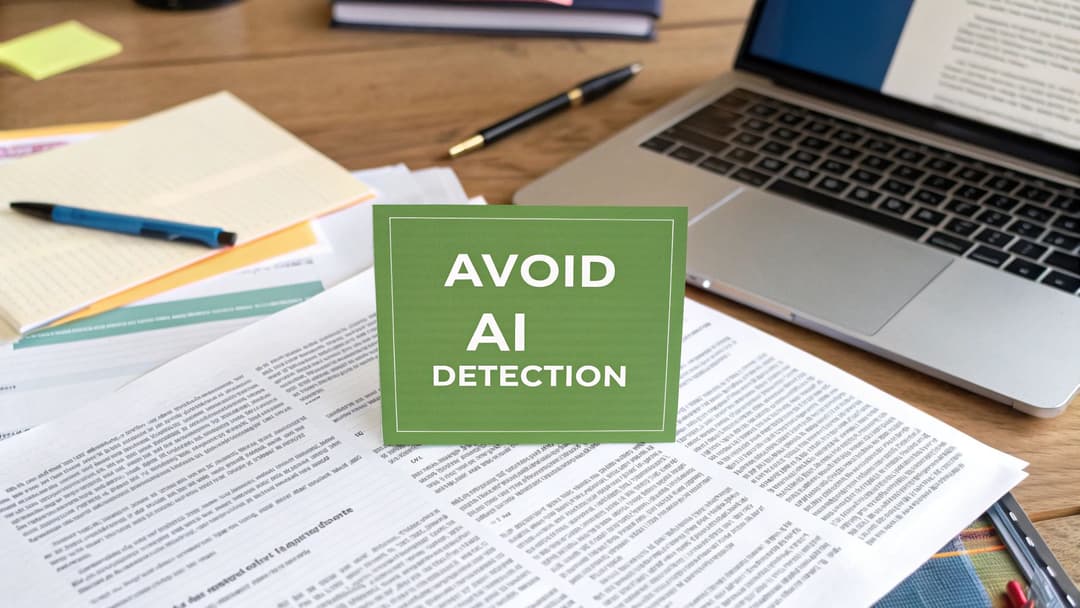
Creating Undetectable AI Content That Works
October 13, 2025
To create AI content that's truly undetectable, you can't just paraphrase a few words. It's about a fundamental rewrite. You have to get in there and mess with the text's DNA—the sentence structures, the word choices, the tone—until it mirrors the beautiful, messy, and unpredictable patterns of a human writer.
The Reality of Modern AI Content Detection

The line between human and AI writing is getting fuzzier by the day. For marketers, students, and creators, AI assistants aren't a gimmick anymore; they're a standard part of the toolkit. The real challenge isn't just generating content anymore. It's getting that content past sophisticated detectors like Turnitin and GPTZero without setting off alarm bells.
This has kicked off a cat-and-mouse game between AI writing tools and the tech designed to spot them. Knowing how to make your AI drafts feel human is now a core skill, not just a neat trick. It’s about keeping your brand voice consistent, creating SEO content that feels real, and making sure your academic work doesn't get unfairly flagged.
The Growing Need for a Human Touch
The push for human-like AI writing comes from very real, practical needs. Let's be honest, raw AI text often feels bland and misses the nuance needed to actually connect with people. Worse, it's easily sniffed out by algorithms looking for those tell-tale predictable patterns.
This creates a few big problems:
- For SEO Specialists: Content that gets flagged as robotic or low-quality will struggle to rank. Search engines are getting smarter about prioritizing genuine, helpful information written for people.
- For Students: An essay flagged by Turnitin can trigger accusations of academic dishonesty, even if you just used AI as a brainstorming partner.
- For Marketers: A brand voice that sounds like it came from a machine is a trust-killer. It fails to build the authority and connection you need with your audience.
The thing to remember is that AI detectors don't measure truth or quality. They measure predictability. Your job is to break that predictability.
This guide is a no-fluff walkthrough for handling this new reality. We’ll focus on actionable steps you can take to make your AI content genuinely undetectable. But first, understanding the basics of how AI detectors work is the best place to start.
Why AI Detectors Get It Wrong So Often
Before you can make AI content truly undetectable, you have to understand the shaky ground AI detectors are built on. These tools aren't magic. They're just algorithms trained to sniff out patterns common in machine-generated text, and they’re surprisingly easy to trip up.
They're mostly hunting for two key signals: perplexity and burstiness.
Think of perplexity as how predictable the writing is. AI models, especially older ones, are wired to pick the most statistically obvious next word. This makes for very smooth, but also very bland and predictable, sentences. Human writing, on the other hand, is a bit messy and far less predictable—we make surprising word choices and don't always follow the most logical path.
Then there's burstiness, which is all about rhythm. Humans naturally mix it up. We write short, punchy sentences. Then we follow them with longer, more detailed ones. This creates a natural ebb and flow. AI often spits out text where every sentence is roughly the same length, creating a monotonous drone that detectors are trained to flag.
The Problem Is Baked In
Detectors work by scoring text based on how closely it matches these predictable, uniform patterns. The less varied it is—low perplexity and low burstiness—the more likely it is to be flagged as AI.
But that very system is their biggest weakness.
A human writer who is trying to be clear and concise can easily fall into these same patterns by accident. At the same time, newer AI models are getting much better at faking variation, making them harder and harder to tell apart from human writers.
This leads to a massive accuracy problem. The tech is notorious for false positives, which means it frequently flags perfectly good human writing as AI-generated.

As you can see, trusting these tools completely is a bad bet. There’s a real risk your own work could get misidentified.
High Error Rates and an Endless Game of Catch-Up
The whole field is a moving target. AI models evolve so quickly that the detectors are always one step behind. A tool that was calibrated for an older model might be completely useless against something generated by a newer one.
Here’s a quick look at just how unreliable the data shows these detectors to be.
| AI Detector Performance Snapshot | |
|---|---|
| Metric | Reported Statistic |
| False Positive Rate (Human Flagged as AI) | Can be as high as 28% |
| False Negative Rate (AI Missed) | Roughly 20% of AI content goes undetected |
| Average False Positive Rate (Top Tools) | Around 22% |
These numbers paint a clear picture: this is a technology with serious flaws. You can explore more insights about these AI detection tools if you want to dig deeper into the data.
Humanizing AI-generated content isn't about fooling a perfect system. It's about adding the natural variation and nuance that today's imperfect detection technology simply can't handle.
At the end of the day, your goal is to create great content that connects with people. By understanding how these detectors work—and where they fail—you can focus your energy on adding those distinctly human touches that make the text authentically yours. And as a bonus, it’ll sail right past the detectors.
A Practical Guide to Humanizing AI Text

Alright, this is where the theory ends and the real work begins. Getting AI content to sound human isn’t about vague advice like "add a story." It's a hands-on editing process where you break down the robotic structure of an AI draft and rebuild it with your own touch.
Think of it less like simple paraphrasing and more like fundamentally altering the text’s DNA. To do this, you have to attack the two biggest tells for AI detectors: sentence uniformity and predictable word choice. By manually forcing some variety into the writing, you disrupt the very patterns those algorithms are trained to spot.
Master Sentence Structure and Variety
One of the first things you'll notice about AI text is its monotonous rhythm. Most sentences are roughly the same medium length and follow a similar structure, which basically screams "machine-written" to a detector. Your first job is to become a sentence architect and start mixing things up.
- Mix long and short sentences. Follow a long, descriptive sentence with a short, punchy one. It’s a simple trick, but it dramatically boosts the "burstiness" score and makes the text feel far more dynamic.
- Vary your sentence starters. AI has its favorite openers. You'll see a lot of "Additionally," "Furthermore," and "In conclusion." Hunt these down and rephrase them for a more natural flow.
- Use more complex structures. Throw in some clauses, parenthetical asides—heck, even a well-placed semicolon. Anything to break up the simple subject-verb-object pattern that AI defaults to. This naturally increases the text's perplexity.
If you want to go deeper on this, our guide on converting https://naturalwrite.com/blog/ai-to-human-text offers even more techniques. It's all about making the text less predictable at every turn.
Hunt Down and Replace AI Filler Words
Some words are just dead giveaways. Because AI models are trained on massive datasets, they often lean on overly formal or clichéd terms that sound smart but feel hollow. To create undetectable AI content, you need to put on your word-detective hat.
Your mission is to find these robotic crutches and swap them out for more natural, engaging language.
Your goal is to swap out words that an AI would choose for words that a person would actually say. It’s about replacing statistical probability with genuine expression.
Here's a list of common culprits to watch for:
- "Delve": Just say "explore," "look into," or even "dig into."
- "Leverage": "Use" or "take advantage of" works perfectly fine.
- "Tapestry": This is a classic AI favorite. Be more specific and describe what you actually mean.
- "Showcase": Try "show," "highlight," or "demonstrate."
- "Crucial" or "Pivotal": Simpler words like "important" or "key" are often better.
This isn’t just about finding synonyms. It's about choosing words that fit the tone and context of your piece, adding a layer of authenticity that algorithms have a hard time replicating.
Inject Your Unique Voice and Personality
The final, and maybe most important, layer is adding you to the text. Raw AI content is generic by design. It has no opinions, no sense of humor, and no unique perspective. This is your biggest advantage.
Think about how you can give the content a distinct personality. You could add a bit of humor, a skeptical aside, or use industry-specific jargon that an AI wouldn't know how to use correctly.
Let's look at an example.
AI-Generated Version:
"It is important to utilize a multi-faceted approach to digital marketing. This ensures a comprehensive strategy that covers all potential customer touchpoints."
Humanized Version:
"Don't just throw everything at the wall and hope it sticks. A smart marketing plan means you're intentionally showing up where your customers actually are, not just blasting ads into the void."
See the difference? The second version has a clear voice. It's conversational ("sticks," "blasting ads") and offers a strong point of view. This is the kind of nuance that makes content truly undetectable. For those looking for tools to help with this, you can check out Redact AI's official website for solutions that assist in this transformation process.
Advanced Strategies for Professional Creators
When you're creating content at scale, every minute you spend editing is a minute you're not publishing. The real secret to efficiency isn't just about churning out text faster; it's about getting better first drafts from your AI—drafts that barely need any manual work.
This is where you move beyond simple prompts and start building a persona-driven workflow. Instead of just giving the AI a one-off command, you're going to train it to become your writer. The whole idea is to slash your editing time by getting the AI to adopt your unique style before it even starts writing.
Think of it this way: you're turning a generic tool into a specialized assistant, one that already knows your brand's voice, tone, and formatting quirks.
Building a Reusable AI Persona
One of the most powerful things you can do is create a detailed persona or style guide that you can plug into every prompt. This becomes a set of custom instructions that tells the AI exactly how to think and write for you. It's a one-time setup for long-term consistency.
Your custom instructions should cover a few key areas:
- Tone of Voice: Are you witty and informal? Or more authoritative and direct? Use descriptive words and maybe even an example sentence or two.
- Vocabulary Preferences: Make a list of words you love and, just as importantly, words you hate. This is the perfect place to forbid all those classic AI filler words we talked about earlier.
- Sentence Structure: Tell the AI you want variety. I often instruct it to "use a mix of short, punchy sentences and longer, more descriptive ones."
- Formatting Rules: Be specific. Instruct it to use short paragraphs, bullet points for lists, and to bold key terms for emphasis.
By creating a detailed persona, you're not just giving the AI a task; you're giving it an identity. This is how you build a consistent brand voice and produce high-quality, undetectable AI content without starting from scratch every time.
Once your persona is ready, you can kick off every session by telling the AI to "write in the persona of..." That simple command activates all your rules, saving you from having to repeat yourself over and over. It’s all about working smarter.
The Power of Emulation and Examples
The absolute best way to teach an AI a specific style? Show, don't just tell. An AI learns by analyzing examples, much like a human writer learns by reading the work of others.
Before you ask it to write something new, feed it a sample of text that’s a perfect example of what you want. This could be one of your top-performing blog posts, a snippet of ad copy, or a page from your website.
Try a prompt like this:
"Analyze the writing style, tone, and structure of the text below. Notice the conversational language, short paragraphs, and how it explains things simply. [Paste your example text here]. Now, using that exact style, write a 500-word article about..."
This approach forces the AI to break out of its default mode and actively mimic the patterns in your example. It’s an incredibly effective way to get a first draft that's already 80% of the way there, leaving you with just the final 20% of human polishing.
For creators wanting to take this even further, understanding the mechanics behind the curtain is a game-changer. Digging into something like this tutorial on creating an AI text generator plugin can give you ideas for building truly custom solutions.
Navigating Content Ownership and Ethics

Getting AI content to feel human isn’t just about the technical side of things. It's also a walk on an ethical and legal tightrope. As you start weaving AI-generated text into your workflow, you quickly run into a huge question with no simple answer: who actually owns this stuff?
This gray area is something you can't afford to ignore. It’s all about protecting your work and making sure your brand is built on a solid foundation.
The whole problem boils down to authorship. If there’s no clear human author, there's usually no clear path to getting copyright protection. This is where all your humanizing efforts pay off in a big way—they're not just about beating detectors; they're your claim to ownership.
Securing Your Copyright
The legal side of AI content is getting a lot of attention right now. There's a big debate over who owns AI-generated material, and the current take from U.S. law is pretty clear: purely machine-made text doesn't qualify for copyright protection.
That is, unless it goes through meaningful human editing. This legal stance is exactly why humanizing your drafts is so critical. Learn more about the complexities of AI content ownership on undetectable.ai.
Your edits, the insights you add, and the unique spin you put on the phrasing—that’s what turns a generic AI output into your own intellectual property. It’s that human touch that gives you a real, legal claim to authorship.
Always Read the Fine Print
Before you marry an AI platform, you have to dig into its terms of service. Seriously. Not all tools handle ownership the same way, and you might be unpleasantly surprised by what's buried in the legal jargon.
- Some platforms might claim partial rights to whatever you generate, which could restrict how you use it.
- Others could use your inputs and outputs to train their models—a potential red flag if you’re working with sensitive information.
- The good ones will have clear terms that state you keep full ownership of the final, edited content.
Understanding these terms isn't just about ticking a box. It’s about protecting your intellectual property. You don't want to build a valuable content asset only to discover you don't actually own it.
At the end of the day, you need a mindset shift. Think of AI as an assistant, not the author. You are the creator. The final responsibility for the content's quality, originality, and ownership rests squarely on your shoulders. By taking charge of the editing process, you ensure your work is not only undetectable but also ethically sound and legally yours.
A Few Lingering Questions
Let's clear the air on a few common questions that pop up when talking about undetectable AI content. Think of this as the practical advice section, where we tackle the concerns that really matter.
Will AI Detectors Ever Be Perfect?
It’s highly unlikely. And honestly, it’s not something you should lose sleep over.
AI detection is all about pattern recognition. But the AI models creating the text are getting better and better at mimicking human writing. This creates a constant cat-and-mouse game where the detectors are always a step behind.
Your energy is better spent creating genuinely good content, not trying to outsmart a flawed system. When you focus on value, readability, and your own unique insights, you naturally sidestep the robotic patterns these tools are built to catch.
Is Humanizing AI Content Going to Hurt My SEO?
Not at all. In fact, it's one of the best things you can do for it.
Google has been shouting from the rooftops for years about helpful, reliable, people-first content. This is exactly what their E-E-A-T guidelines (Experience, Expertise, Authoritativeness, and Trustworthiness) are all about.
When you refine an AI draft—adding your own stories, clarifying points, and checking facts—you're doing precisely what Google wants. You're making it better for people. Raw, unedited AI text is what's truly at risk of getting buried in search results.
Good SEO has always been about writing for people first, algorithms second. Humanizing AI text is a direct investment in that idea, making your content more valuable to your audience and to search engines.
Does Making AI Content Undetectable Feel a Little…Unethical?
This all comes down to intent. Let’s be real.
If you’re trying to pass off someone else’s work as your own, spread bad information, or just churn out low-effort spam, then yes, that’s unethical. The tool isn’t the problem; the goal is.
But if you’re using AI as a starting point to beat writer’s block or speed up your process? That's a completely different story. Taking that AI draft and making it your own—editing, fact-checking, and infusing it with your own voice—is just a smart way to work.
Ultimately, you have to own the final product. You're the author. You're the editor. You are responsible for making sure the content is accurate, helpful, and truly reflects your expertise.
Ready to turn those clunky AI drafts into something that sounds like you? Natural Write can help. Our one-click humanizer polishes your text to fly past AI detectors without losing your core message.
Start creating undetectable AI content with confidence. You can learn more about Natural Write here.


